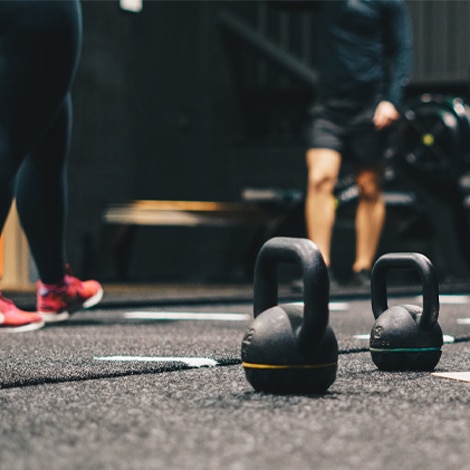By Tricia Sterland and Dave Grant
We just returned from the 2022 AUSA Annual Meeting & Exposition in Washington, D.C., where the Smartabase team showcased our new, purpose-built human performance optimization (HPO) solution for the military, attended panel discussions, and met with leadership from the U.S. Army and armed forces across the globe. In this article, we’ll share some of the main themes and topics, and explore how they relate to the increasing investment in data-informed military HPO programs.
This was the first time that AUSA has had a Human Performance Pavilion, hosted by BeaverFit. As they wrote, this brought together “equipment, services, and product solutions to support the development and maintenance of the Soldier Weapon System.”i Five years ago, performance in the Army was almost exclusively focused on whether service members passed or failed fitness tests and tactical assessments. But with advances in technology and the Holistic Health and Fitness (H2F) system and Preservation of the Force and Family (POTFF) program prioritizing a broader approach, the scope of military human performance has expanded to encompass physical, cognitive, spiritual, and emotional elements. So there were plenty of attendees who were interested in seeing how the Smartabase platform captured quantitative data from multiple devices and enabled easy input of important qualitative feedback during workouts in the pavilion. The system then aggregated this information and instantly displayed the results.
Recruiting and Retaining Talent
During a panel discussion titled “In a War for Talent – Recruiting, Retention and Opportunity,” General Gary M. Brito, Commanding General of TRADOC and other Army leaders described how the service fell short of its recruitment goal last year.ii Part of the problem is that only 23 percent of 18 to 25-year-olds met the physical and educational standards to enlist for active-duty service. To help improve the preparedness of potential recruits, the Army launched the Future Soldier Preparatory Course pilot program.iii The Smartabase Military HPO Solution could enhance such an initiative by collating physical and cognitive test scores so that the data lifecycle of future soldiers begins before they even enlist.
Another issue that the panelists shared was retaining service members and extending their careers. One of the biggest challenges for active-duty personnel in this area is the rate of attrition. Injuries play a major part in this. While some combat and collision-related incidents are unavoidable, many others are preventable. Units in the Army and other branches of the military are using Smartabase to create risk profiles and flag factors that make service members more likely to get hurt, such as poor sleep, soreness, or sudden decreases in performance. Instructors can then intervene to minimize the impact of these indicators, lower the chances of injury, and increase availability and retention. Some units have reduced preventable injuries by 31 percent. At scale, this improves overall force capability.
When an injury occurs, it’s easier to manage if all staff involved in the continuum of care have access to the same comprehensive, up-to-date information. By uniting medical, performance, and wellness data, Smartabase provides a 360-degree view of the service member. A return-to-duty dashboard summarizes their daily status, and practitioners can drill down into more finite details, if needed, to inform next steps and return the individual to full readiness without rushing them back too soon. This has helped certain military groups reduce sit days by 27 percent and save $79 million by rehabbing injured service members faster.
Maintaining Readiness and Lethality
With Russia continuing to wage war against Ukraine and tensions running high between China and Taiwan, the exhortation that former U.S. Secretary of Defense James Mattis delivered at a previous AUSA event rang true at this year’s expo: “Be ready.”iv From the hardware on display, it was clear that the military is deploying more unmanned aircraft and less piloted planes and helicopters. This means that there’s a greater number of service members than ever before who are emphasizing cognitive skills. Drone pilots, cyber defense roles, and those in other jobs that need them to stay mentally sharp shouldn’t underestimate how other aspects of preparedness play into their day-to-day functions. Physical training, sleep, nutrition, and mental health all contribute to cognitive performance.
A system such as Smartabase can track all these elements and ensure that whether someone is on or behind the front line, at a desk, or anywhere in between, they maintain mental, physical, emotional, and spiritual readiness. The ability to not only monitor objective physiological metrics but also capture subjective data from daily wellness questionnaires and the Army’s Spiritual Readiness Assessment (SRA) provides instructors and commanders with greater context for maximizing the performance, wellness, and availability of those they lead.
When talking to senior Army officers at AUSA, it became clear that one of the main barriers to maintaining force readiness and lethality is managing human performance data at scale. Each H2F program can include up to 22,000 troops with a very limited number of practitioners, making it difficult to capture and maintain data. One Army leader told us that on the front end, information is often still handwritten on paper forms, leading to a staff member spending half a day each week entering testing data into an Excel spreadsheet – and that was just for the Army Combat Fitness Test (ACFT).
As a result, this commander believed that he needed to hire a data scientist to keep up with the volume of incoming information. While this could be helpful, it might not be necessary if he had a system that could eliminate the need for manual data entry and provide greater value by incorporating additional data sets. Smartabase makes it easier to capture data for the ACFT and other assessments by replacing pen and paper with a digital kiosk that allows for fast and accurate input. This is then automatically consolidated with other metrics to provide a more complete picture of each service member’s overall performance and wellness, in keeping with the H2F initiative that’s a central part of the Army’s People First strategy.
Finding the Why Behind the Whats
Once a set of performance data has been entered through a manual process, it can show what happened in a particular situation but doesn’t explain the reasons for it because there’s no context around the information. For example, it’s easy to get an overall pass/fail rate for the ACFT, and then to see how many service members fell short of the standards for the deadlift, two-mile run, and so on. But because the data exists in isolation, it’s hard to go any further. Smartabase provides the why behind the what by combining objective and subjective data across all five H2F pillars. So perhaps 30 percent of recruits who failed the deadlift slept poorly, 25 percent had additional life stress, and 15 percent were unmotivated. When they understand the reasons for performance issues, staff can start intervening to address the underlying issues.
This is only possible when service members’ performance data isn’t stuck in disparate silos. One of the questions we got a lot at AUSA 2022 was, “How do I bring all our data together in one place?” The person would then proceed to tell us about all the systems, databases, and spreadsheets they had and explain that none of them were talking to each other. This means that only specialists in one discipline or location had access to the information that they’d captured, limiting their effectiveness, hindering collaboration with other practitioners, and undermining the quality of the training and care they delivered to service members. It’s not merely the volume of data that military units are finding difficult to manage, but also the sheer variety of it and the inability to overlay different data points from separate systems.
This is where the “bring your own device” (BYOD) approach that Smartabase facilitates comes into play. As our demo in the AUSA Human Performance Pavilion highlighted, versatile integration options enable military units to pull in service member data from a wide range of sources, consolidate it, and then display it instantly. These inputs include performance-focused systems and devices and domain-specific technology like blast gauges.
Supporting All Five H2F Pillars
Once we’d shared how Smartabase consolidates different data streams, AUSA attendees were curious about how the aggregated information is presented. We showed them that the same information could be reported on in various ways and at both vertical and horizontal levels, depending on who’s viewing it and the lens that their role requires. It was interesting to hear that while commanders wanted to see echelon-level insights that would indicate overall force readiness and lethality, they were also curious about how data would be communicated to individual service members. Flexible customizable visualization options make it easy to show a high-level overview of an entire fighting force to leadership and to give a service member’s data back to them in such a way that they can understand and act upon it.
Our conversations at the conference revealed that sometimes people who are new to human performance are most interested in a particular type of data or a technology like wearables. Although this might lead to a limited perspective, the good news is that every pillar of the H2F system feeds into the others. We sometimes describe human performance as a wheel with many spokes, including sleep, nutrition, physical fitness, spirituality, and mental health. What we’ve seen from working closely with Army groups on H2F and USSOCOM on POTFF is that wherever you enter this circle, it has a positive knock-on effect. For example, Dr. Lisa Miller, professor of psychology and education at Columbia University who has partnered with the Army Chaplains Corps, found that those with greater spiritual readiness are 80 percent less likely to abuse drugs and alcohol and have lower rates of depression.v
At AUSA 2022, it was clear that to respond to ever-changing current events, today’s military needs to recruit more talented service members, retain them, and develop their overall readiness and wellbeing. The ability of Smartabase to capture information automatically, consolidate it in a single platform, and make it actionable in data-backed decision-making can fulfill the promise of human performance optimization technology as a force multiplier throughout the life cycle of the soldier or operator.








